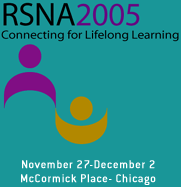
Abstract Archives of the RSNA, 2005
SSQ01-02
Correlation between Radiologist Interpretations and Computer Aided Detection of Screening Mammograms in a Dedicated Breast Imaging Practice
Scientific Papers
Presented on December 1, 2005
Presented as part of SSQ01: Breast (Computer-assisted Detection)
Aman Daftary MBBS, Abstract Co-Author: Nothing to Disclose
Lara Lyn Bryan-Rest MD, Presenter: Nothing to Disclose
Regina J. Hooley MD, Abstract Co-Author: Nothing to Disclose
Laura Jean Horvath MD, Abstract Co-Author: Nothing to Disclose
Irena Tocino MD, Abstract Co-Author: Nothing to Disclose
Jennifer Fan MD, Abstract Co-Author: Nothing to Disclose
Liane Elizabeth Philpotts MD, Abstract Co-Author: Nothing to Disclose
et al, Abstract Co-Author: Nothing to Disclose
To assess the value of computer aided detection (CAD) in a dedicated breast imaging practice by correlating radiologist interpretations with CAD markings in screening mammograms.
A prospective study of all screening mammogram interpretations at our institution was performed over a three month period. Screening mammograms were performed at three sites which included one digital and five analog units. All studies were processed on a commercially available CAD system (R2). Mammograms were interpreted by one of five dedicated breast imagers with 4-20 years experience.
Mammograms were reviewed for abnormal findings including density, mass, calcifications and architectural distortion. After initial interpretation CAD markings were correlated with the radiologist’s findings. Follow up diagnostic mammograms were reviewed when available
Six hundred and twenty seven screening mammograms were performed with a 15 % (94/627) call back rate. CAD correctly identified call back findings detected by the radiologist in 50% (47/94) of cases. The correlation varied with different mammographic findings: calcifications 72% (16/22), masses 47% (25/53), densities 35% (6/17) and architectural distortion 0 % (0/2). CAD influenced the radiologist interpretation in only 5% of cases.
Of the 47 call back cases that did not have a CAD correlate, follow up was available in 26. 35% (9/26) of these findings were BIRADS 2, 57% (15/26) were BIRADS 3 and 8% (2/28) were BIRADS 4.
Of the 94 call back cases, 29 were digital and 65 were analog. The CAD correlation in digital mammograms was 52% (15/29) and in analog studies it was 49% (32/65).
CAD findings correlate with dedicated breast imagers’ findings in only 50% of cases. The correlation of CAD with calcifications was the best while with architectural distortion was the worst. There was no difference in CAD correlation based on digital or analog technique. Given the poor correlation of CAD with expert breast imagers interpretation, complete dependence on CAD for reading of screening mammograms is greatly discouraged.
Daftary, A,
Bryan-Rest, L,
Hooley, R,
Horvath, L,
Tocino, I,
Fan, J,
Philpotts, L,
et al, ,
Correlation between Radiologist Interpretations and Computer Aided Detection of Screening Mammograms in a Dedicated Breast Imaging Practice. Radiological Society of North America 2005 Scientific Assembly and Annual Meeting, November 27 - December 2, 2005 ,Chicago IL.
http://archive.rsna.org/2005/4412348.html

